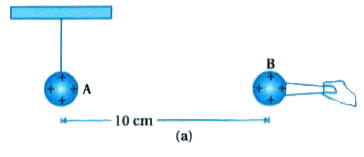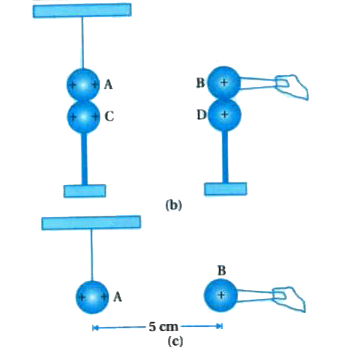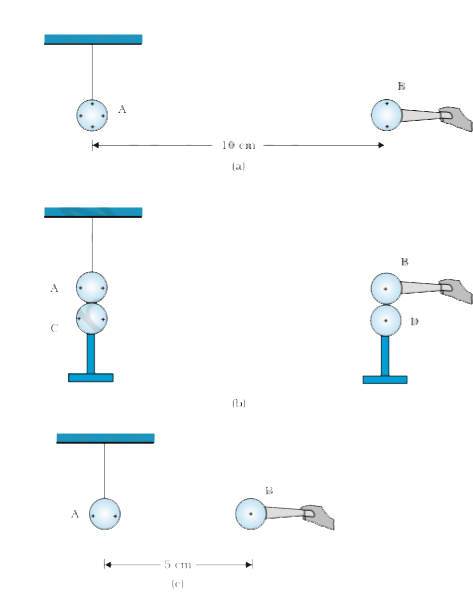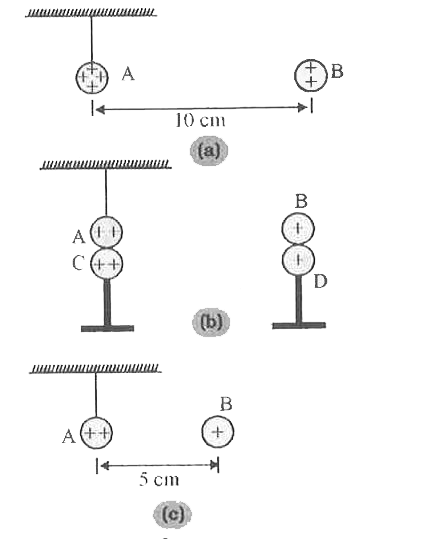A charged metallic sphere A is suspended by a nylon thread. Another charged metallic sphere B held by an insulating handle is brought close to A such that the distance between their centres is 10 cm, as shown in figure (a). The resulting repulsion of A is noted (for example, by shining a beam of light and measuring the deflection of its shadow on a screen). Spheres A and B are touched by uncharged spheres C and D respectively, as shown in figure (b). C and D are then removed and B is brought closer to A to a distance of 5.0 cm between their centres, as shown in figure (c). What is the expected repulsion of A on the basis of Coulomb's law ? Spheres A and C and spheres B and D have identical sizes. Ignore the sizes of A and B in comparison to the separation between their centres.

 Solution in Gujrati
Solution in Gujrati
Coulombian force between A and B initially,
…….(1)
When A and C are brought in contact and then separated charge on each of them will be,
……..(2)
Similarly when B and D are brought in contact and then separated charge on each of them will be,
.......(3)
Now, when A and B are kept at if new Coulombian force between them is F. then,
........(4)
From equation (1) and (4),
Topper's Solved these Questions
- ELECTRIC CHARGES AND FIELDS BOOK - KUMAR PRAKASHANCHAPTER - ELECTRIC CHARGES AND FIELDS EXERCISE - SECTION B NUMERICALS (NUMERICAL FROM TEXTUAL EXERCISES)
24 Videos
- ELECTRIC CHARGES AND FIELDS BOOK - KUMAR PRAKASHANCHAPTER - ELECTRIC CHARGES AND FIELDS EXERCISE - SECTION B NUMERICALS (ADDITONAL EXERCISE)
10 Videos
- ELECTRIC CHARGES AND FIELDS BOOK - KUMAR PRAKASHANCHAPTER - ELECTRIC CHARGES AND FIELDS EXERCISE - SECTION A QUESTIONS- ANSWERS (TRY YOURSELF )
73 Videos
- DUAL NATURE OF RADIATION AND MATTERBOOK - KUMAR PRAKASHANCHAPTER - DUAL NATURE OF RADIATION AND MATTEREXERCISE - Section-D (MCQs asked in GUJCET/Board Exam)
1 Videos
- ELECTROMAGNETIC INDUCTIONBOOK - KUMAR PRAKASHANCHAPTER - ELECTROMAGNETIC INDUCTIONEXERCISE - Section D MCQs (MCQs asked in Competitive Exams )
38 Videos
Similar Questions
What is the force between two small charged spheres having charges of 2×10−7C and 3×10−7 C placed 30 cm apart in air ?
View SolutionAn oil drop of 12 excess electrons is held stationary under a constant electric field of 2.55×104NC−1. (Millikan's oil drop experiment). The density of the oil is 1.26gcm−3. Estimate the radius of the drop, (g=9.81ms−2,e=1.60×10−19C).
View SolutionWhy spark is seen while removal of synthetic clothes in dark in winter?
View SolutionMass of photon in motion is ………
View SolutionThree pure inductance each of 3 H are connected as shown in figure. The equivalent inductance of this connection between points A and B is ......

View SolutionA metal sphere is suspended from a nylon thread. Initially, the metal sphere is uncharged. When a positively charged glass rod is brought close to the metal sphere, the sphere is drawn towards the rod. But if the sphere touches the rod, it suddenly flies away from the rod. Explain, why the sphere is first attracted then repelled?
View SolutionA charged metallic sphere A is suspended by a nylon thread. Another charged metallic sphere B held by an insulating handle is brought close to A such that the distance between their centres is 10 cm, as shown in Fig. 1.7(a). The resulting repulsion of A is noted (for example, by shining a beam of light and measuring the deflection of its shadow on a screen). Spheres A and B are touched by uncharged spheres C and D respectively, as shown in Fig. 1.7(b). C and D are then removed and B is brought closer to A to a distance of 5.0 cm between their centres, as shown in Fig. 1.7(c). What is the expected repulsion of A on the basis of Coulomb’s law? Spheres A and C and spheres B and D have identical sizes. Ignore the sizes of A and B in comparison to the separation between their centres.

View SolutionA charged metallic sphere A is suspended by a nylon thread. Another charged metallic sphere B held by an insulating handle is brought close to A such that the distance between their centres is 10 cm, as shown in Fig. 1.7(a). The resulting repulsion of A is noted (for example, by shining a beam of light and measuring the deflection of its shadow on a screen). Spheres A and B are touched by uncharged spheres C and D respectively, as shown in Fig. 1.7(b). C and D are then removed and B is brought closer to A to a distance of 5.0 cm between their centres, as shown in Fig. 1.7(c). What is the expected repulsion of A on the basis of Coulomb’s law? Spheres A and C and spheres B and D have identical sizes. Ignore the sizes of A and B in comparison to the separation between their centres.

View SolutionThree metal spheres A,B and C are mounted on insulating stands. The spheres are touching one another, as shown in the diagram A strong positively charged object it brought near sphere A and a strong negative charge is brought near sphere C. While the charged objects remains near spheres A anc C, sphere B is removed by means of its insulating stand. After the charged objects are removed, sphere B is first touched to sphere A and then to sphere C. The resulting charge on B would be-
View Solutionधातु का आवेशित गोला A नायलॉन के धागे से निलंबित है। विद्युतरोधी हत्थी द्वारा किसी अन्य धातु के आवेशित गोले B को A के इतने निकट लाया जाता है कि चित्र (a) में दर्शाए अनुसार इनके केंद्रों के बीच की दूरी 10cm गोले के परिणामी प्रतिकर्षण को नोट किया जाता है (उदाहरणार्थ-गोले पर चमकीला प्रकाश पुंज डालकर तथा अंशांकित पर्दे पर बनी इसकी छाया का विक्षेपण मापकर)। A तथा B गोलों को चित्र (b) में दर्शाए अनुसार क्रमशः अनावेशित गोलों C तथा D से स्पर्श कराया जाता है। तत्पश्चात् चित्र (c) में दर्शाए अनुसार C तथा D को हटाकर B को A के इतना निकट लाया जाता है कि इनके केंद्रों के बीच की दूरी 5.0 cm हो जाती है। कूलॉम नियम के अनुसार A का कितना अपेक्षित प्रतिकर्षण है? गोले A तथा C एवं गोले B तथा D के साइज सर्वसम हैं। A तथा B के केंद्रों के पृथक्कन की तुलना में इनके साइजों की उपेक्षा कीजिए।

View Solutionधातु के एक गोले A पर +10μC आवेश है। इसे दूसरे समान गोले B से स्पर्श कराया जाता है। गोले A पर कितना आवेश रह जायेगा ?
View SolutionA charged metalic sphere A is suspended by a nylon thread. Another charged metallic sphere B held by an insulating handle is brought close to A such that the distance between their centres is 10 cm, as shown in Fig. (a). The resulting repulsion of A is noted (for example, by shining a beam of light and measuring the deflection of its shadow on a screen). Spheres A and B are touched by uncharged spheres C and D respectively, as shown in Fig. (b). C and D are then removed and B is brought closer to A to distance of 5.0 cm between their centres, as shown in Fig. (c). what is the expected repulsion of A on the basis of Coulomb's law? Spheres A and C and spheres B and D have identical sizes. Ignore the size of A and B in comparison to the separation between their centres.
View SolutionThe weight of each of two small metal spheres having same amount of charge is 3g. The two spheres are suspended with tow threads of length 13 cm each from a point. Due to mutual repulsion they are at rest at a distance of 10 cm. Determine the charge on each sphere and tension in the threads.
View SolutionThe mass of a metal sphere charged with +20 esu is 2g. Another smaller sphere with -128 esu of charge is suspended with a thread. The former sphere, just below this smaller one, is at rest. What is the distance between the centres of the two spheres? g="980 cm . s"^(-2)
View Solutionधातु का आवेशित गोला A नायलॉन के धागे से निलंबित है। विद्युतरोधी हत्थी द्वारा किसी अन्य धातु के आवेशित गोले B को A के इतने निकट लाया जाता है कि चित्र (a) में दर्शाए अनुसार इनके केंद्रों के बीच की दूरी 10cm गोले के परिणामी प्रतिकर्षण को नोट किया जाता है (उदाहरणार्थ-गोले पर चमकीला प्रकाश पुंज डालकर तथा अंशांकित पर्दे पर बनी इसकी छाया का विक्षेपण मापकर)। A तथा B गोलों को चित्र (b) में दर्शाए अनुसार क्रमशः अनावेशित गोलों C तथा D से स्पर्श कराया जाता है। तत्पश्चात् चित्र (c) में दर्शाए अनुसार C तथा D को हटाकर B को A के इतना निकट लाया जाता है कि इनके केंद्रों के बीच की दूरी 5.0 cm हो जाती है। कूलॉम नियम के अनुसार A का कितना अपेक्षित प्रतिकर्षण है? गोले A तथा C एवं गोले B तथा D के साइज सर्वसम हैं। A तथा B के केंद्रों के पृथक्कन की तुलना में इनके साइजों की उपेक्षा कीजिए।

View Solution
